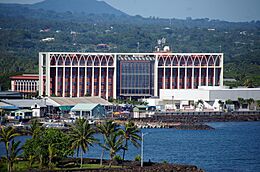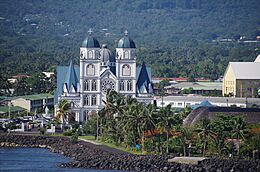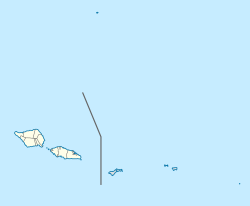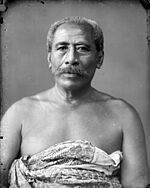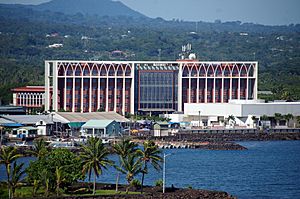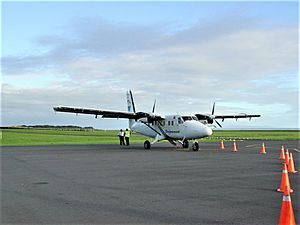Apia facts for kids
Quick facts for kids
Apia
|
|
|---|---|
|
(from top: left to right) Government Building in Apia, Central Bank of Samoa, Apia Airport and The Immaculate Conception Cathedral of Apia.
|
|

Map of Apia
|
|
| Country | Samoa |
| District | Tuamasaga |
| Constituency | Vaimauga West and Faleata East |
| Founded | 1850s |
| Became Capital | 1959 |
| Area | |
| • City | 47.80 sq mi (123.81 km2) |
| • Urban | 20.0 sq mi (51.8 km2) |
| Elevation | 7 ft (2 m) |
| Population
(2021)
|
|
| • City | 35,974 |
| • Density | 752.54/sq mi (290.558/km2) |
| • Urban | 35,974 |
| • Urban density | 1,798.7/sq mi (694.5/km2) |
| Time zone | UTC+13 (WST) |
| Climate | Af |
Apia is the capital and only city of Samoa. It is found on the central north coast of Upolu. Upolu is Samoa's second-largest island. Apia is located in the political district (itūmālō) of Tuamasaga.
The Apia Urban Area is often called the City of Apia. It had about 35,974 people in 2021. Its borders stretch from Letogo village in the east to Vaitele village in the west. This western area is newer and has more factories.
Contents
History of Apia
Apia started as a small village. In the 1800s, only 304 people lived there. The country's capital got its name from this village. Apia Village still exists today within the bigger city of Apia. The city has grown to include many other villages. Each village in Samoa, including Apia Village, has its own matai (leaders) and fa'alupega (traditional greetings).
The modern city of Apia was founded in the 1850s. It has been the official capital of Samoa since 1959. Seumanutafa Pogai was a powerful chief until he passed away in 1898.
In 1889, Apia's harbour was the scene of a famous event. Seven ships from Germany, the US, and Britain were in the harbour. A typhoon was coming, but no ship wanted to leave first. They didn't want to look weak. The storm hit, and all ships sank or were badly damaged. Only the British ship Calliope managed to escape. Nearly 200 American and German sailors died.
From 1900 to 1914, Germany ruled Western Samoa, and Apia was its capital. This time was known as German Samoa.
In August 1914, soldiers from New Zealand took control of German Samoa. New Zealand then governed the islands until Samoa became independent in 1962.
In the early 1900s, Samoa fought for its freedom. This fight was led by the Mau movement. Many peaceful protests and marches happened in Apia's streets. Many Samoans were arrested. On December 28, 1929, a sad event happened. During a peaceful Mau gathering, the New Zealand police killed the important chief Tupua Tamasese Lealofi III. This day became known as "Black Saturday."
During World War II, the United States Navy built and ran a naval base in Upolu from 1941 to 1944.
Geography and Climate
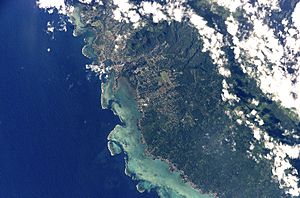
Apia is located on a natural harbour. This harbour is at the mouth of the Vaisigano River. The city is on a narrow flat area near the coast. To its south is Mount Vaea, which is 472 meters high. This mountain is where the famous writer Robert Louis Stevenson is buried.
Two main hills run south along the Vaisigano River. Roads are built on each of these hills. One of these roads is the Cross Island Road. It is one of the few roads that goes from the north to the south coast of Upolu.
Apia's Weather
Apia has a tropical rainforest climate. This means it has warm temperatures all year round. The weather is not exactly equatorial because of the trade winds. There are also a few cyclones.
The driest months in Apia are July and August. During these months, about 80 mm of rain falls. The wettest months are December to March. In these months, more than 300 mm of rain can fall each month. The average temperature in Apia is about 26 degrees Celsius. Apia gets about 3000 mm of rain every year.
| Climate data for Apia (Elevation: 2 m or 6.6 ft) (1991–2020 normals, extremes 1971–2020) | |||||||||||||
|---|---|---|---|---|---|---|---|---|---|---|---|---|---|
| Month | Jan | Feb | Mar | Apr | May | Jun | Jul | Aug | Sep | Oct | Nov | Dec | Year |
| Record high °C (°F) | 36.2 (97.2) |
34.6 (94.3) |
35.2 (95.4) |
36 (97) |
37.6 (99.7) |
34.7 (94.5) |
33.7 (92.7) |
35.9 (96.6) |
35.3 (95.5) |
34.8 (94.6) |
34.9 (94.8) |
35.1 (95.2) |
37.6 (99.7) |
| Mean daily maximum °C (°F) | 30.6 (87.1) |
30.8 (87.4) |
30.9 (87.6) |
31.1 (88.0) |
30.6 (87.1) |
30.2 (86.4) |
29.8 (85.6) |
29.8 (85.6) |
30 (86) |
30.2 (86.4) |
30.5 (86.9) |
30.7 (87.3) |
30.4 (86.8) |
| Daily mean °C (°F) | 27.6 (81.7) |
27.7 (81.9) |
27.7 (81.9) |
27.8 (82.0) |
27.3 (81.1) |
27.1 (80.8) |
26.6 (79.9) |
26.6 (79.9) |
26.8 (80.2) |
27 (81) |
27.4 (81.3) |
27.5 (81.5) |
27.3 (81.1) |
| Mean daily minimum °C (°F) | 24.5 (76.1) |
24.6 (76.3) |
24.5 (76.1) |
24.5 (76.1) |
24 (75) |
23.9 (75.0) |
23.5 (74.3) |
23.4 (74.1) |
23.6 (74.5) |
23.9 (75.0) |
24.2 (75.6) |
24.4 (75.9) |
24.1 (75.3) |
| Record low °C (°F) | 16.2 (61.2) |
19.5 (67.1) |
20.7 (69.3) |
19.5 (67.1) |
14.9 (58.8) |
17.6 (63.7) |
17.9 (64.2) |
18.1 (64.6) |
17.5 (63.5) |
19.4 (66.9) |
18.9 (66.0) |
19.5 (67.1) |
14.9 (58.8) |
| Average precipitation mm (inches) | 482.8 (19.01) |
406.3 (16.00) |
302 (11.9) |
231.8 (9.13) |
244.6 (9.63) |
139.2 (5.48) |
132.8 (5.23) |
112.3 (4.42) |
143.3 (5.64) |
220.7 (8.69) |
260.5 (10.26) |
413.7 (16.29) |
3,090 (121.68) |
| Average precipitation days (≥ 1.0 mm) | 20.5 | 18.4 | 18.1 | 13.9 | 13.2 | 10.1 | 10.7 | 9.9 | 12 | 13.1 | 15.5 | 17.8 | 173.2 |
| Mean monthly sunshine hours | 149 | 160 | 173 | 186 | 193 | 197 | 213 | 219 | 207 | 199 | 181 | 154 | 2,230 |
| Source 1: World Meteorological Organization | |||||||||||||
| Source 2: World Bank (sunshine 1971–2000) | |||||||||||||
How Apia is Governed
Apia is part of the Tuamasaga political district. It also belongs to several election districts. Apia does not have one single city government. Instead, it is made up of about 45 separate villages. Each of these villages has its own traditional leaders.
Apia proper is a small village between the Vaisigano and Mulivai rivers. It is surrounded by other traditional villages like Matautu and Vaiala. These villages, along with some newer areas, make up "Downtown Apia."
In 2004, a law called the Planning and Urban Management Act was passed. This law helps plan for Apia's growth. The city has grown quickly, which has caused some problems. For example, flooding is common during the rainy season because the city is built on low ground. Also, there are issues with pollution near the coast.
Because Apia has many separate village governments, it has been hard to create one plan for things like sewage disposal. More cars on the road have also led to traffic jams. The new law created an authority to help manage these issues and plan for Apia's future.
What to See in Apia
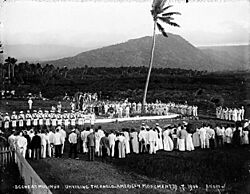
Mulinu'u is an old ceremonial capital located at the western end of Apia. Here you can find the Parliament House (Maota Fono). There is also a historic observatory built during the German era, which is now the meteorology office.
The main Catholic cathedral in Apia is the Immaculate Conception of Mary Cathedral. The original church was built in 1867. It was taken down in 2011 due to damage from an earthquake. A new, beautiful cathedral was built and opened in 2014.
A special area of land built into the harbour holds the Fiame Mataafa Faumuina Mulinuu II (FMFM II) building. This is a tall government office building named after Samoa's first Prime Minister. The Central Bank of Samoa is also located here. A clock tower, built to remember war heroes, stands as a central point in the city.
The new market (maketi fou) is located inland at Fugalei. This spot helps protect it from strong cyclones. Apia still has some old wooden buildings from the colonial times. One important one is the old courthouse from the German era, which now has a museum upstairs.
In recent years, Apia has seen many new, taller buildings. The ACC building (2001) houses government offices and a bank. Below it, there's a mall with shops and places to eat. The Samoatel building (2004) handles Samoa's international phone and internet connections. It was built inland to protect it from cyclones. The DBS building (2007) holds the Development Bank of Samoa. The Tui Atua Tupua Tamasese Building (2012) houses more government ministries. Another new building is the SNPF Molesi shopping mall, opened in 2013. A new hospital complex was also built at Mot'ootua.
The Scottish writer Robert Louis Stevenson lived his last four years in Apia. He is buried on Mount Vaea, which overlooks the city and his home, Vailima. His home is now a museum. He loved Samoa so much that he was given a Samoan name, Tusitala, meaning "Teller of Tales."
The Falemata'aga - Museum of Samoa is in an old German colonial school building in the city.
Apia is also home to one of the eight Bahá’í Houses of Worship in the world. It was designed by Hossein Amanat and opened in 1984. It is a place where people of all backgrounds can come together to meditate and pray.
Economy and Transport
Apia's Economy
Talofa Airways and Samoa Airways have their main offices in Apia. The Grey Investment Group also has its headquarters downtown. This company owned Samoa's first private bank, the National Bank of Samoa. Grey Investment also owns many properties in Samoa and New Zealand.
Getting Around Apia
Apia Harbour is the biggest and busiest harbour in Samoa. Large ships carrying containers, gas, and fuel dock here. Ferries also leave from here to Tokelau and American Samoa.
Apia has a good network of roads that are usually well-kept. Most main roads are paved. Since September 7, 2009, vehicles in Samoa drive on the left side of the road. The government started a big project in 2012 to make the main roads around Apia wider.
Samoa does not have trains or trams. However, there is a large system of private buses and taxis. People often walk around the town or even outside it. There are not many bicycles or motorcycles. But with more cars, traffic jams have become common, leading to the need for better roads.
The main international airport, Faleolo International Airport, is about a 40-minute drive west of Apia. Samoa's main airlines, Polynesian Airlines and Talofa Airways, use this airport. Fagali'i Airport, a smaller airstrip, was used for flights within Samoa and to Pago Pago in American Samoa.
Education in Apia
Apia has many schools for all ages. These include pre-schools, primary schools, and secondary schools. It is also home to Samoa's only university, the National University of Samoa. The University of the South Pacific also has a campus in Alafua, just outside Apia, for agriculture studies. Another important school in Apia is Robert Louis Stevenson School. It is a private school for primary and secondary students. Many children from wealthy families in Samoa attend this school.
Universities in Apia
- National University of Samoa
- University of the South Pacific
- Oceania University of Medicine
Colleges in Upolu Island
- LDS Church College of Pesega, Pesega
- Faatuatua Christian College, Vaitele Fou
- Leififi College, Leififi
- Leulumoega-fou College, Malua
- Maluafou College, Maluafou
- Saint Joseph's College, Alafua
- Saint Mary's College, Vaimoso
- Samoa College, Vaivase Tai
- Seventh Day Adventist College, Lalovaea
- Robert Louis Stevenson College, Tafaigata
- Wesley College, Faleula
- Nuuausala College, Nofoalii
- Paul V1 College, Leulumoega Tuai
- Chanel College, Moamoa
- Avele College, Vailima
- Lepa Lotofaga College
- Palalaua College, Siumu
- Aleipata College
- Anoamaa College
- Falealili College
- Safata College
- Aana No. 1 College
- Aana No. 2 College
- Sagaga College
Colleges in Savaii Island
- Tuasivi College
- LDS Church College of Vaiola
- Wesleyan College (Uesiliana)
- Don Bosco College
- Itu O Tane College
- Palauli College
- Palauli I Sisifo College
- Amoa College
- Vaimauga College
- Papauta Girls College
- Mataevave College
Primary Schools in Apia
Most villages have their own primary schools. However, many primary schools in downtown Apia are run by Churches.
- Robert Louis Stevenson School, Lotopa
- Marist Brothers' School, Mulivai
- Saint Mary's School, Savalalo
- Peace Chapel School, Vaimea
- Apia Baptist School, Aai o Niue
- Seventh-day Adventist Primary School, Lalovaea
- All Saints Anglican School, Malifa
Sports in Apia
Pacific Games
Apia hosted the Pacific Games for the first time in 1983. The Games came back to Apia in 2007. In those games, Samoa finished in third place. About 20,000 people watched the closing ceremony of the 2007 Games at Apia Park.
Football (Soccer)
Apia hosted the qualification matches for the 2010 FIFA World Cup for the Oceania region. This means Apia was where the first goal of the 2010 qualifiers was scored. It was scored by Pierre Wajoka of New Caledonia against Tahiti. All matches were played at the Toleafoa J.S. Blatter Complex. This complex is named after FIFA president Sepp Blatter. It is also the home stadium for the Samoa national football team and can hold 3,500 fans.
Judo
From 2009 to 2012, Apia hosted the IJF Judo World Cup. In 2013, it became a smaller regional tournament called the 'Oceania Open'.
Cricket
Apia hosted the 2012 ICC World Cricket League Division Eight tournament. This event took place at the Faleata Oval's, which has four cricket grounds. Teams from Samoa, Belgium, Japan, Suriname, Ghana, Bhutan, Norway, and Vanuatu played in it. This was the first time an official tournament from the International Cricket Council was held in the region.
Basketball
Apia hosted the 2018 FIBA Polynesia Basketball Cup. Samoa's national basketball team finished as the runner-up in this tournament.
Sister cities
 Shenzhen, Guangdong, China (2015)
Shenzhen, Guangdong, China (2015) Compton, California, United States (2010)
Compton, California, United States (2010) Oranjestad, Aruba (2012)
Oranjestad, Aruba (2012) Riohacha, Colombia (2019)
Riohacha, Colombia (2019) Taipei, Republic of China
Taipei, Republic of China
See also
 In Spanish: Apia para niños
In Spanish: Apia para niños


